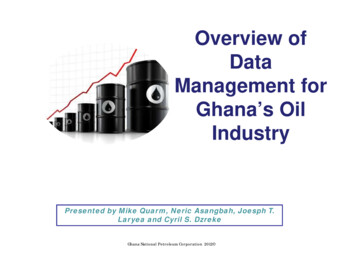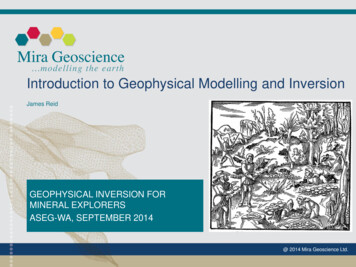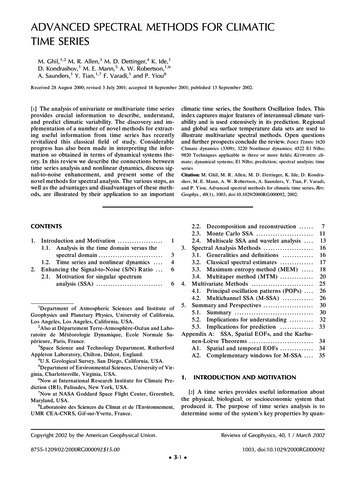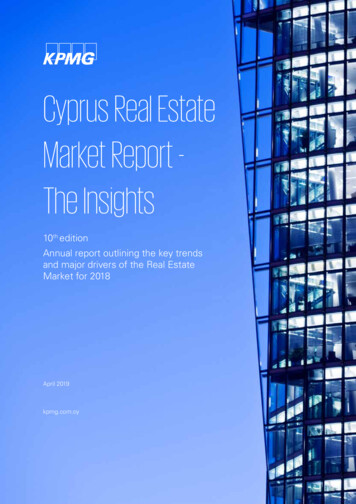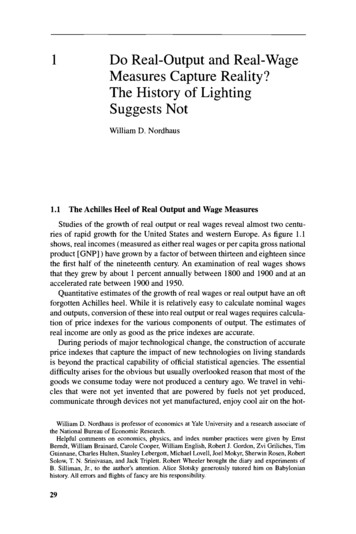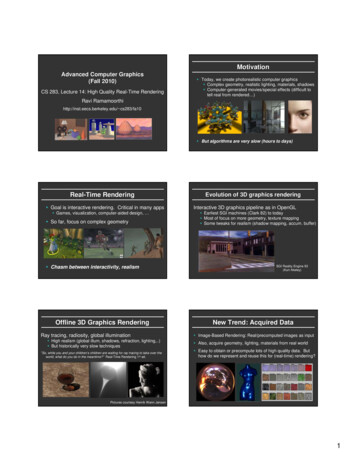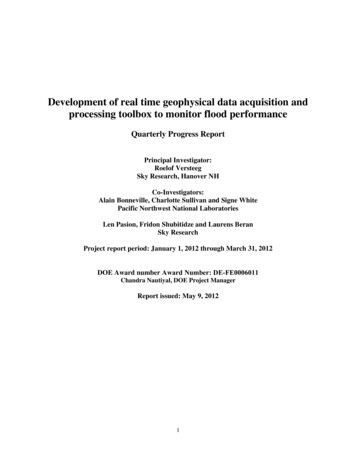
Transcription
Development of real time geophysical data acquisition andprocessing toolbox to monitor flood performanceQuarterly Progress ReportPrincipal Investigator:Roelof VersteegSky Research, Hanover NHCo-Investigators:Alain Bonneville, Charlotte Sullivan and Signe WhitePacific Northwest National LaboratoriesLen Pasion, Fridon Shubitidze and Laurens BeranSky ResearchProject report period: January 1, 2012 through March 31, 2012DOE Award number Award Number: DE-FE0006011Chandra Nautiyal, DOE Project ManagerReport issued: May 9, 20121
DisclaimerThis report was prepared as an account of work sponsored by an agency of the United States Government.Neither the United States Government nor any agency thereof, nor any of their employees, makes anywarranty, express or implied, or assumes any legal liability or responsibility for the accuracy,completeness, or usefulness of any information, apparatus, product, or process disclosed, or representsthat its use would not infringe privately owned rights. Reference herein to any specific commercialproduct, process, or service by trade name, trademark, manufacturer, or otherwise does not necessarilyconstitute or imply its endorsement, recommendation, or favoring by the United States Government orany agency thereof. The views and opinions of authors expressed herein do not necessarily state or reflectthose of the United States Government or any agency thereof.2
AcknowledgementThe material presented in this report is based upon work supported by the U.S. Department of Energy,National Energy Technology Laboratory, under Award Number : DE-FE00060113
Executive SummaryThe team of Sky Research and Pacific National Northwest Laboratory are engaged in a project funded bythe National Energy Technology Laboratory, Strategic Center for Natural Gas and Oil in the U.S.Department of Energy to develop and validate novel non invasive methods to monitor and quantify CO2EOR flood performance.The project is divided into three research phases corresponding to the three budget periods. The emphasisin Phase I (Budget Period: February 1, 2011 through February 1, 2012) was on site selection, numericalmodeling of CO2 EOR flooring and associated expected geophysical signatures for a number of differentgeophysical sensing modalities for selected sites, and on sensing modality selection. The emphasis inPhase II (Budget period: February 1, 2012 through February 1, 2013) is on refinement of the modelingscenarios, sensing system assembly and testing and on inverse method development. The emphasis inPhase III (Budget period: February 1, 2013 through February 1, 2014) will be on the system fielddeployment on a selected site and on the interpretation of the field data. This report covers the reportingperiod of January 1, 2012 through March 31, 2012 (last month of Phase I, first two months of Phase II)The primary achievements in Phase I included A literature review was completed to assess the feasibility of using different sensing modalities toimage CO2 EOR An agreement was put in place between the project team and Morgan Kinder under whichMorgan Kinder will provide (under and NDA with Sky Research and PNNL) access to data forthe Yates and Katz fields (two fields in which Kinder Morgan in performing CO2 EOR). Modeling using the PNNL developed code STOMP and the commercial code GEM was started tosimulate different CO2 EOR scenarios Modeling efforts using several geophysical modeling codes were initiated to perform sensitivitystudies for different geophysical Initial system design was started for both a TDEM (Time domain Electro Magnetic) and ERT(Electrical Resistivity Tomography) system which would be used in the monitoring phaseIn February of 2012 the project team submitted a continuation application discussing the achievementsunder Phase I. On February 23 a presentation was given to DOE staff on Phase I, and following that DOEgave permission to proceed to Phase II of the project. Phase II is now underway4
ContentsDisclaimer.2Acknowledgement .3Executive Summary .4List of Figures. 512Introduction .61.1Background . 61.2Scope of Work . 6Progress of work .62.1Site commitment. 62.2Literature review. 72.3Modeling . 72.3.1CO2 Modeling . 72.3.2Geophysical modeling . 102.4345Sensor system design and layout . 11Milestone status . 123.1Milestone description . 123.2Milestone status . 133.3Any changes in approach or aims and reasons for change. 153.4Actual or anticipated problems or delays and actions taken or planned to resolve them. . 153.5Any absences or changes of key personnel or changes in consortium/team arrangement. . 15Appendix A. Statement of Project Objectives . 154.1PROJECT OBJECTIVE . 154.2SCOPE OF WORK . 154.3TASKS TO BE PERFORMED . 16Cost/Plan Status . 21List of FiguresFigure 1 GS3 platform for modeling process and data management. .8Figure 2 Distribution of physical properties resulting from CO2 injection simulation performed using STOMP. Error! Bookmark not defined.5
1 Introduction1.1 BackgroundThe team consisting of Sky Research and Pacific National Northwest Laboratory is engaged in a projectfunded by the National Energy Technology Laboratory, Strategic Center for Natural Gas and Oil in theU.S. Department of Energy to develop and validate novel non invasive methods to monitor and quantifyCO2 EOR flood performance.The motivation for this project is the need for next generation imaging capabilities of CO2 EOR floods.Specifically, such imaging capabilities should allow companies involved in CO2 EOR the capability toobtain timely and actionable information about CO2 EOR floods which would allow for the optimizationof such floods through injection parameter tuning. The ability to optimize floods is expected to increasethe number of sites at which CO2 EOR can be economically applied, and thus result in increases in (andreduction in the cost of) tertiary oil production.1.2 Scope of WorkThe scope of the project is the design, development and validation of a real time, semi-autonomous,multisensory geophysical data acquisition and processing system to monitor CO2-EORflood performance. This system will consist of a combination of commercially available andrecipient developed geophysical sensors which will collect continuous geophysical data. Theacquisition system will be integrated with middleware to provide for automated transmission of datato a server for data management and near real time processing and inversion. The output of the dataprocessing (changes in physical properties resulting from the geophysical inversion) will be coupledto reservoir models (specifically, the PNNL developed STOMP code) to provide for near real timeestimates of CO2 flooding performance. The detailed scope of work is provided in appendix A.There are three phases of research in this project: Phase 1 (system design), Phase 2 (systemconstruction) and Phase 3 (system field testing). These phases generally correspond to the three yearsof the project. The project started on February 1, 2011, and this report covers the fifth three monthperiod of the project, which focused on the completion of Phase I and started work on Phase II.2 Progress of work2.1 Site commitmentFollowing the project award discussions were had with both DOE funded projects, academia and industryto explore the potential of monitoring at sites where CO2 EOR is either ongoing or planned. Sitesincluded SACROC, the Citronella field in Alabama, Chaparral Energy's North Burbank Unit site (NEOK) and multiple sites in the Permian Basin. Several of these operators are interested in the technology.6
An agreement was obtained with Morgan Kinder under which Morgan Kinder will provide data on twofields (Katz and Yates) where CO2 EOR is occurring. This data will be used by the project team in themodeling effort and the subsequent site ranking.2.2 Literature reviewA literature review on the feasibility of CO2 EOR monitoring using a range of different geophysicalsensing modalities was completed and submitted to the DOE PM. A journal article based on this review isbeing prepared. The summary of the literature review are1. Theoretical, numerical and field based evidence exists that CO2 EOR emplacement can beobserved and monitored both with gravity, active seismic, electrical and electromagneticmethods. Surface deformation monitoring techniques (INSAR & tiltmeters) can also observe andmonitor CO2 EOR emplacement. While passive seismic data can sometimes be used to locate theinitial emplacement passive seismic data is not suitable for monitoring.2. The magnitude of the changes in measurements is dependent on the combination of severalfactors, includinga. volume of CO2 injectedb. host conditions of the reservoirc. distance between the geophysical sensors and the injectiond. geometry of the geophysical sensorse. injection history3. There is a good agreement between the actual magnitudes of changes observed in field data andthe numerically and theoretically predicted values. This indicates that numerical methods can beused effectively to predict the efficiency of geophysical monitoring of CO2 EOR.2.3 Modeling2.3.1CO2 ModelingThis task consisted of development and implementation of a forward model that allows the simulation ofchanges in physical properties (electrical, electromagnetic, density and acoustic properties) associatedwith the injection of CO2 for typical EOR field applications.The modeling effort in phase 1 has two parts. The first part is the modeling of specific CO2 EORscenarios for a range of different systems using the PNNL Stomp code and a commercial reservoirsimulation code. The second part is the modeling of the geophysical signal using a range of forwardgeophysical models. In phase 2 the geological modeling and geophysical inversion will be integrated inthe PNNL developed Geological Sequestration Software Suite (GS3) (Figure 1 which provides a processby which teams can accomplish the simulation process, while the system automatically manages the data,data translations, versions of conceptual and numerical models, captures provenance and user annotation,and in doing so, vastly reduce the burden on modelers for manually organizing and tracking informationthroughout the modeling process.7
Figure 1 GS3 platform for modeling process and data management.Under this task the project team is using two different simulation engines. The first is the PNNLdeveloped Stomp code, which has been used successfully for simulation of multiple CO2 sequestrationscenarios (Figure 2). While it has been verified extensively and can model multiple different systemsSTOMP is primarily a research code, which originated as a reactive transport code for environmentalapplications. The second is the commercial GEM (Generalized Equation-of-State Model ReservoirSimulator ) code. GEM is a full equation-of-state compositional reservoir simulator which has beenwidely applied to model the effect of CO2 injection in oil reservoirs. The project team decided to use bothcodes side by side, both to validate the STOMP performance and as the GEM code turned out to becurrently better suited for rapid model evaluation and for the modeling of the behavior of the Yates Field.Code development on STOMP is ongoing outside of the current project which should allow us to useSTOMP for the simulation of Yates in year 2, and both STOMP and GEM can be used in our inverseframework approach8
Figure 2 Output of the PNNL developed STOMP modeling codeThe simulators provide spatial and temporal distributions of porosity, temperature, pressure, chemistry,and relative concentration and phase of oil, water/brine, gas and CO2. These concentrations will beinput in a petrophysical model for transforming these values into changes in density and electricalconductivity. For this, an experimental relationship has been developed (modified Archie's law), whichis based on theoretical, laboratory and field measurements of changes in density and electricalconductivity as a result of CO2 flooding. The coefficients for this relationship are site specific, and workis currently ongoing to determine these coefficients for the Katz and Yates field.Data have been received from Kinder Morgan allowing for the construction of geocellular models ofboth the Katz and Yates field. These data were received in January of 2012. Forward models arecurrently being run and refined with interactions occurring between the program team and modelersfrom Kinder Morgan.9
2.3.2Geophysical modelingUnder this task forward geophysical modeling codes were developed allowing for the calculation ofchanges in geophysical measurements for a number of sensing modalities and instrumentconfigurations. Codes were developed for forward modeling of gravity, resistivity and Time DomainElectromagnetic sensing modalities. These codes were developed in Fortran 90 (Time Domain EM),Matlab (resistivity) and Comsol Multiphysics (Time Domain EM, resistivity and gravity). These codeswere validated for simple test scenarios, but await the full completion of task 2.3 to be able to simulatethe changes in geophysical properties from CO2 injection for the Katz and Yates fields. As these forwardmodels can be rapidly executed, we expect these efforts to be completed shortly after completion oftask 2.3.Sensitivity studies were done for a number of different geometries, both including surface transmittersand borehole receivers and borehole transmitters and borehole receivers (Figure 3)Figure 3 Configuration for sensitivity study: left surface transmitters and borehole receivers. Right: boreholetransmitters and receivers.The initial result of this is that a borehole to borehole system will provide superior visibility (Figure 4), and thatfrequency dependent data will improve detectability of changes10
Figure 4 Changes over time in EM signal associated with CO2 injection2.4 Sensor system design and layoutThe sensor system design will predominantly occur in Phase 2. However, one of the questions waswhether our system would need to be independently powered or whether it could use in field availablepower. Based on the discussions with Kinder Morgan for our two test sites we currently feel that oursystem will be able to use either the existing power infrastructure for both the geophysical sensors and theoverall data acquisition infrastructure. In parallel with the geophysical modeling effort we are evaluatingcommercial and in house developed hardware for both resistivity, electromagnetic and gravity dataacquisition. Specifically, we are examining the feasibility of integrating experimental gravitygradiometers and/or borehole resistivity and borehole em transmitters/receivers in our system. As part ofthis discussions are being held with different manufacturers as to the cost and availability of differenthardware elements. We evaluated several possible vendors for such systems including MultiPhaseTechnologies, Zonge and AGI and purchased a multi channel, 64 electrode system from Multiphasetechnologies which is currently being configured for autonomous operation. For the TDEM system weanticipate using a combination of a surface transmitter (either a large loop or galvanic source), coupledwith either surface or borehole receivers, either wideband B-field receivers or dB/dt sensors. Sky hasexperience with several of these sensors as well as the integration of these sensors in compact receiverpackages (Figure 5), and we are currently working on the completion of the sensor package.11
Figure 5 Left: general concept of borehole sensor. Top right: three component EM sensor. Bottom right: prototype SERFmagnetometer.3 Milestone status3.1 Milestone descriptionThe project is divided into three research phases corresponding to the three budget periods. The emphasisin Phase I (Budget Period: February 1, 2011 through February 1, 2012) is on site selection, numericalmodeling of CO2 EOR flooring and associated expected geophysical signatures for a number of differentgeophysical sensing modalities for selected sites, and on sensing modality selection. The emphasis inPhase II (Budget period: February 1, 2012 through February 1, 2013) will be on sensing system assemblyand testing and on inverse method development. The emphasis in Phase III (Budget period: February 1,2013 through February 1, 2014) will be on the system field deployment on a selected site and on theinterpretation of the field data.12
The effort includes 9 milestones. Table 1 lists the name, planned start and complection date of each milestone, aswell as the task or subtask with which each milestone is associated.TasknumberPlanned startdatePlannedend datePhaseTask nameProject Milestone name2.1Test site commitmentTest site commitment2/1/114/1/1112.2Literature StudyLiterature study2/1/115/1/1112.4Geophysical ForwardModel coupling to CO2induced changes inphysical properties2.5Sensing Modality andGeometry Selection3.2System Constructionand Testing4.1TDEM Processing CodeDevelopment4.3CO2-EOR Model Linkingwith GeophysicalFramework Output5.2System Deployment andData CollectionSystem deploymentData AnalysisData analysis completion61Forward Model coupling5/1/1112/31/111Modality selection7/1/1112/31/112Prototype completion11/1/115/1/122TDEM inverse code11/1/118/1/123Model linking2/1/125/1/13311/1/122/1/132/1/132/1/143As reported in the continuation application, the status of milestones 2.4 and 2.5 has been delayed. A meeting withDOE in July 2012 is planned to update DOE on interim project progress.3.2 Milestone statusMilestone 1: Test site commitmentThis milestone consists of obtaining commitment letters to allow for field deployment of the geophysicalmonitoring system from one or more sites where CO2 EOR is being done. Meeting of this milestone will bedemonstrated by providing these letters to the DOE program office.Milestone status: COMPLETED. An agreement was made with Morgan Kinder under which Morgan Kinder willprovide data for two fields at which Morgan Kinder is performing CO2 EOR. These are the Yates fields and the Katzfield. Morgan Kinder has indicated their willingness to allow monitoring (if several conditions on site safety andrelevancy are met). A copy of the letter was provided to the DOE Program managerMilestone 2: Literature studyThis milestone consists of completion of a literature study about the use of geophysical characterization andmonitoring of CO2 EOR. Meeting of this milestone will be demonstrated by providing this literature study to theDOE program office.Milestone status: COMPLETED. The literature study was completed and provided to the Program Manager.13
Milestone 3: Forward Model couplingThis milestone consists of the coupling of the PNNL developed GS 3 model for CO2 injection with Sky Researchdeveloped geophysical forward models such that the coupled models can predict the geophysical signal associatedwith CO2 EOR efforts. Meeting of this milestone will be demonstrated by performing a series of numericalsimulations which the coupled models. The results of the simulations will be documented in a letter report whichwill be provided to the DOE program officeMilestone status: Ongoing.Milestone 4: Modality selectionThis milestone consists of selection of the sensors and configuration of these sensors which will be used in the fielddemonstration. This milestone will be demonstrated by a report describing the sensor selection and providing thetheoretical, field and numerical data supporting the sensor selection. This report will be provided to the DOEprogram office.Milestone status: Ongoing.Milestone 5: Prototype completionThis milestone consists of the completion of the initial prototype sensor system (note that several of these will beconstructed for deployment, but this milestone concerns the construction of the initial one). This milestone will bedemonstrated by documenting the prototype design specifications, physical assembly (both component andsystem level) and test data resulting from the prototype. The documents will be provided to the DOE programoffice.Milestone status: startedMilestone 6: TDEM (Time Domain Electro Magnetic) inverse codeThis milestone consists of the completion of a TDEM inverse code which can estimate changes in subsurfaceconductivity from TDEM data. This milestone will be demonstrated by processing a number of synthetic (andpossibly field) TDEM datasets and demonstrating that the code can obtain realistic estimated of changes insubsurface conductivity from this data.Milestone status: startedMilestone 7: Model linkingThis milestone consists of the linking of the GS3 model with the geophysical codes to allow for inverse propertyestimation. This milestone will be demonstrated by executing a number of scenarios on synthetic data to show thecoupling and property estimation. A document summarizing the results of these scenarios will be provided to theDOE program office.Milestone status: startedMilestone 8: System deploymentThis milestone consists of the deployment to the field site of the monitoring hardware and the start of datacollection. This milestone will be demonstrated by documenting field deployment activities and data collectionprogress (which will be accessible through a password protected interface). A document summarizing field sitedeployment and a password/username allowing access to the data portal will be provided to the DOE programoffice.14
Milestone 9: Data analysis completionThis milestone consists of the completion of the data analysis and processing of the field data collected in the fielddemonstration. This milestone will be demonstrated by a data analysis report which will document field data andprocessing results. This document will be provided to the DOE program office.3.3 Any changes in approach or aims and reasons for change.No changes in approach or aims of this project occurred3.4 Actual or anticipated problems or delays and actions taken or planned toresolve them.As noted in the executive summary the site related modeling has been delayed due to thechallenge of obtaining a site. This has impacts both on the progress and the expending of funds.We are working diligently to resolve this delay and anticipate being able to experience no furtherdelay. We are working with Kinder Morgan towards a system deployment in Q4 of 20123.5 Any absences or changes of key personnel or changes inconsortium/team arrangement.No absences or changes of key personnel or changes in consortium/team agreement occurred4 Appendix A. Statement of Project Objectives4.1 PROJECT OBJECTIVEThe objective of the project is to design, develop and validate a real time, semi- autonomousgeophysical data acquisition and processing system to monitor CO2-EOR flood performance.4.2 SCOPE OF WORKThe scope of the project is the design, development and validation of a real time, semi-autonomous,multisensory geophysical data acquisition and processing system to monitor CO2-EORflood performance. There are three phases of research to be conducted: Phase 1 (system design),Phase 2 (system construction) and Phase 3 (system field testing). This system shall consist of acombination of commercially available and recipient developed geophysical sensors which willcollect continuous geophysical data. The acquisition system shall be integrated with middleware toprovide for automated transmission of data to a server for data management and near real time15
processing and inversion. The output of the data processing (changes in physical properties resultingfrom the geophysical inversion) shall be coupled to reservoir models to provide for near real timeestimates of CO2 flooding performance.4.3 TASKS TO BE PERFORMEDPhase ITask 1.0 – Project Management and PlanningThe Recipient shall execute the project in accordance with the approved Project Management Plan(PMP) covering the entire project period. The Recipient shall manage and control project activities inaccordance with their established processes and procedures to ensure subtasks and tasks are completedwithin schedule and budget constraints defined by the Project Management Plan. This includes trackingand reporting progress and project risks to DOE and other stakeholders.The Recipient shall work with the DOE Project Officer to modify and update the PMP submitted as partof the original application package, as necessary. The revised PMP shall be submitted within 30 days ofthe award. The DOE Project Officer shall have 20 calendar days from receipt of the Project ManagementPlan to review and provide comments to the Recipient. Within 15 calendar days after receipt of theDOE's comments, the Recipient shall submit a final Project Management Plan to the DOE Project Officerfor review and approval.This task shall include all work elements required to maintain and revise the Project Management Plan,and to manage and report on activities in accordance with the plan. The Recipient shall review, update,and amend the Project Management Plan (upon request of the DOE Project Officer) at key points in theprogram, notably at each Budget Period transition or GO/NO-GO decision point (if required) and uponschedule variances of more than three (3) months and cost variances of more than 15%.It shall also include the necessary activities to ensure coordination and planning of the project withDOE/NETL and other project participants. These shall include, but are not limited to, the submission andapproval of required National Environmental Policy Act (NEPA) documentation.The Applicant is restricted from using Federal funds to take any action that would have an adverse affecton the environment or limit the choice of reasonable alternatives prior to DOE providing final NEPAdecision regarding this project.Task 2.0 – Test site selection, sensitivity and Cost/Benefit Studies and SensingModality SelectionThe recipient shall secure commitments from CO2 EOR site operators for the system deploymentassociated with task 5 (field testing). The recipient shall perform a literature study to identify potentialsensing modalities. The recipient shall assess the sensitivity of each potential geophysical sensingmodality to changes in physical properties associated with CO2-EOR and the cost/benefit provided byeach sensing modality in terms of information (both alone and in conjunction with other sensing data).16
From the results of this sensitivity study the recipient shall select the specific sensing modalities for thesystem as well as the performance characteristics (e.g. acquisition lengths, sensitivities, number of unitsrequired, spacing between units). This task shall also include an analysis of the optimal deploymentconfiguration of sensors. This task shall include a modeling study to determine the physical changesassociated with EOR which will be coupled to geophysical forward modeling studies performed by therecipient (Subtask 2.3 – Geophysical forward mode
Development of real time geophysical data acquisition and processing toolbox to monitor flood performance Quarterly Progress Report Principal Investigator: Roelof Versteeg Sky Research, Hanover NH Co-Investigators: Alain Bonneville, Charlotte Sulliva
